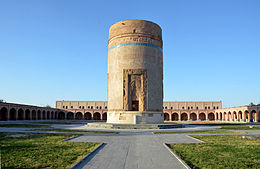Shaykh Haydar
|
Murshid Shaykh Ḥaydar Ṣafavi |
|
|---|---|

Shaykh Haydar's Tomb in Meshginshahr
|
|
| Safaviyya Order | |
|
In office 1460–1488 |
|
| Preceded by | Shaykh Junayd |
| Succeeded by | Soltan-Ali |
| Personal details | |
| Born | June–July 1459 Amed (present-day Diyarbekir, Turkey) |
| Died | 9 July 1488 (aged 28-29) Tabasaran, Dagestan (present-day Russia) |
| Resting place | Ardabil |
| Spouse(s) | Halima (Martha), daughter of Uzun Hasan by Despina Khatun (Theodora Megale Komnene) A daughter of Farid al-din Jafar b. Khojeh Ali |
| Children |
Soltan-Ali Ibrahim Mirza Ismail I Fakhr-Jahan Khanum Malek Khanum Sayyed Hassan |
| Mother | Khadija Begum bt. Qara Othman (sister of Uzun Hasan) |
| Father | Shaykh Junayd |
| Relatives |
Khojeh Mohammad Safavi (brother) Khojeh Jamshid Safavi (brother) Shah Pasha Khatun (sister) |
Shaykh Haydar or Sheikh Haydar (Persian: شیخ حیدر Shaikh Ḥaidar; b. 1459, Amed - d. 9 July 1488, Tabasaran) was the successor of his father (Shaykh Junayd) as leader of the Safaviyya from 1460-1488. Haydar maintained the policies and political ambitions initiated by his father. Under Sheikh Haydar, the Safaviyya became crystallized as a political movement with an increasingly extremist heterodox Twelver Shi'i coloring and Haydar was viewed as a divine figure by his followers. Shaykh Haydar was responsible for instructing his followers to adopt the scarlet headgear of 12 gores commemorating The Twelve Imams, which led to them being designated by the Turkish term Qizilbash "Red Head".
Haydar soon came into conflict with the Shirvanshah's, as well as the Ak Koyunlu, who were allied to the former. Following several campaigns into the North Caucasus, mainly in Circassia and Dagestan, he and his men were eventually trapped in 1488 at Tabasaran by the combined forces of the Shirvanshah Farrukh Yassar and Ya'qub ibn Uzun Hassan of the Ak Koyunlu. In a pitched battled that ensued, Shaykh Haydar and his men were defeated and killed. He was succeeded by his son Soltan-Ali as leader of the Safaviyya. Soltan-Ali was on his part succeeded by Haydar's younger son, who would become the founder of the Safavid dynasty, and known by his regnal name of Ismail I.
Haydar was born in June–July 1459 to Shaykh Junayd by his wife Khadija Begum bt. Qara Othman, a sister of Uzun Hasan of the Ak Koyunlu. His parents had married on the eve Shaykh Junayd invaded Trabzon. Less than a year later, his father was killed in the Battle of Tabasaran. Apart from Haydar, the only surviving sons of Junayd were Khojeh Mohammad Safavi and Khojeh Jamshid Safavi. The only sister of Haydar that survived, Shah-Pasha Khatun, was married off to Mohammad Beg Talish, a pivotal figure in the foundation of the Safavid dynasty in the early 16th century. In 1469-70, Haydar was installed in Ardabil by his uncle Uzun Hassan, who had defeated Jahan Shah of Kara Koyunlu dynasty at the Battle of Chapakchur and established his own authority over its former domains. The Safaviyya return to Ardabil prompted an influx of Haydar’s followers from northern Syria and eastern Anatolia to Ardabil to be beside him.
...
Wikipedia
